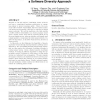Free Online Productivity Tools
i2Speak
i2Symbol
i2OCR
iTex2Img
iWeb2Print
iWeb2Shot
i2Type
iPdf2Split
iPdf2Merge
i2Bopomofo
i2Arabic
i2Style
i2Image
i2PDF
iLatex2Rtf
Sci2ools
MOBIHOC
2008
ACM
2008
ACM
Improving sensor network immunity under worm attacks: a software diversity approach
Because of cost and resource constraints, sensor nodes do not have a complicated hardware architecture or operating system to protect program safety. Hence, the notorious buffer-overflow vulnerability that has caused numerous Internet worm attacks could also be exploited to attack sensor networks. We call the malicious code that exploits a buffer-overflow vulnerability in a sensor program sensor worm. Clearly, sensor worm will be a serious threat, if not the most dangerous one, when an attacker could simply send a single packet to compromise the entire sensor network. Despite its importance, so far little work has been focused on sensor worms. In this work, we first illustrate the feasibility of launching sensor worms through real experiments on Mica2 motes. Inspired by the survivability through heterogeneity philosophy, we then explore the technique of software diversity to combat sensor worms. Given a limited number of software versions, we design an efficient algorithm to assign th...
| Added | 24 Dec 2009 |
| Updated | 24 Dec 2009 |
| Type | Conference |
| Year | 2008 |
| Where | MOBIHOC |
| Authors | Yi Yang, Sencun Zhu, Guohong Cao |
Comments (0)

